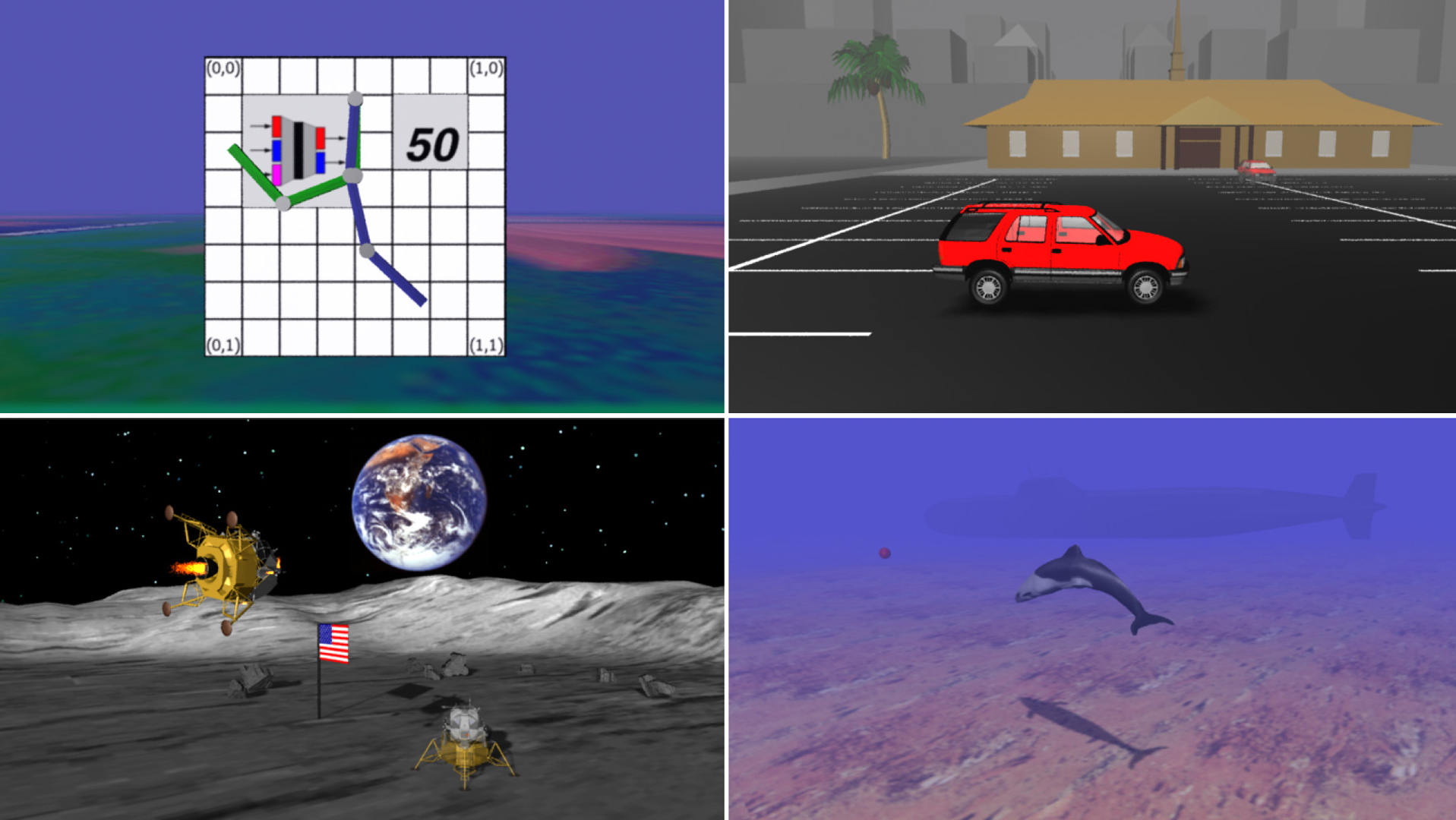“NeuroAnimator: fast neural network emulation and control of physics-based models” by Grzeszczuk, Terzopoulos and Hinton
Conference:
Type(s):
Title:
- NeuroAnimator: fast neural network emulation and control of physics-based models
Presenter(s)/Author(s):
Abstract:
Animation through the numerical simulation of physics-based graphics models offers unsurpassed realism, but it can be computationally demanding. Likewise, the search for controllers that enable physics-based models to produce desired animations usually entails formidable computational cost. This paper demonstrates the possibility of replacing the numerical simulation and control of dynamic models with a dramatically more efficient alternative. In particular, we propose the NeuroAnimator, a novel approach to creating physically realistic animation that exploits neural networks. NeuroAnimators are automatically trained off-line to emulate physical dynamics through the observation of physics-based models in action. Depending on the model, its neural network emulator can yield physically realistic animation one or two orders of magnitude faster than conventional numerical simulation. Furthermore, by exploiting the network structure of the NeuroAnimator, we introduce a fast algorithm for learning controllers that enables either physics-based models or their neural network emulators to synthesize motions satisfying prescribed animation goals. We demonstrate NeuroAnimators for a variety of physics-based models.
References:
1. David Baraff. Analytical methods for dynamic simulation of non-penetrating rigid bodies. In Jeffrey Lane, editor, Computer Graphics (SIGGRAPH ’89 Proceedings), volume 23, pages 223-232, July 1989.
2. C.M. Bishop. Neural Networks for Pattern Recognition. Clarendon Press, 1995.
3. G. Cybenko. Approximation by superposition of sigmoidal function. Mathematics of Control Signals and Systems, 2(4):303-314, 1989.
4. R. Grzeszczuk. NeuroAnimator: Fast Neural Network Emulation and Control of Physics-BasedModels. PhD thesis, Department of Computer Science, University of Toronto, May 1998.
5. Radek Grzeszczuk and Demetri Terzopoulos. Automated learning of Muscle- Actuated locomotion through control abstraction. In Robert Cook, editor, SIG- GRAPH 95 Conference P1vceedings, Annual Conference Series, pages 63-70. ACM SIGGRAPH, Addison Wesley, August 1995. held in Los Angeles, California, 06-11 August 1995.
6. James K. Hahn. Realistic animation of rigid bodies. In John Dill, editor, Computer Graphics (SIGGRAPH ’88 P~vceedings), volume 22, pages 299-308, August 1988.
7. Jessica K. Hodgins, Wayne L. Wooten, David C. Brogan, and James F. O’Brien. Animating human athletics. In Robert Cook, editor, SIGGRAPH 95 Conference P~vceedings, Annual Conference Series, pages 71-78. ACM SIGGRAPH, Addison Wesley, August 1995. held in Los Angeles, California, 06-11 August 1995.
8. K. Hornik, M. Stinchcomb, and H. White. Multilayer feedforward networks are universal approximators. Neural Networks, 2:359-366, 1989.
9. M. I. Jordan and D. E. Rumelhart. Supervised learning with a distal teacher. Cognitive Science, 16:307-354, 1992.
10. Gavin S. P. Miller. The motion dynamics of snakes and worms. In John Dill, editor, Computer Graphics (SIGGRAPH ’88 P~vceedings), volume 22, pages 169-178, August 1988.
11. J. Thomas Ngo and Joe Marks. Spacetime constraints revisited. In James T. Kajiya, editor, Computer Graphics (SIGGRAPH ’93 P1vceedings), volume 27, pages 343-350, August 1993.
12. D. Nguyen and B. Widrow. The truck backer-upper: An example of self-learning in neural networks. In P~vceedings of the International Joint Conference on Neural Networks, volume 2, pages 357-363. IEEE Press, 1989.
13. W.H. Press, S. A. Teukolsky, W. T. Vetterling, and B. P. Flannery. Numerical Recipes: The Art of Scientific Computing, SecondEd#ion. Cambridge University Press, 1992.
14. G. Ridsdale. Connectionist modeling of skill dynamics. Journal of Visualization and Computer Animation, 1 (2):66-72, 1990.
15. D.E. Rumelhart, G. E. Hinton, and R. J. Williams. Learning internal representations by error backpropagation. In D. E. Rumelhart, J. L. McCleland, and the PDP Research Group, editors, Parallel Distributed Processing: Explorations in the Mic~vstructure of Cognition, volume 1, pages 318-362. MIT Press, 1986.
16. Karl Sims. Evolving virtual creatures. In Andrew Glassner, editor, P~vceedings of SIGGRAPH ’94 (Orlando, Florida, July 24-29, 1994), Computer Graphics Proceedings, Annual Conference Series, pages 15-22. ACM SIGGRAPH, ACM Press, July 1994. ISBN 0-89791-667-0.
17. Demetri Terzopoulos, John Platt, Alan Barr, and Kurt Fleischer. Elastically deformable models. In Maureen C. Stone, editor, Computer Graphics (SIGGRAPH ’87 P~vceedings), volume 21, pages 205-214, July 1987.
18. Xiaoyuan Tu and Demetri Terzopoulos. Artificial fishes: Physics, locomotion, perception, behavior. In Andrew Glassner, editor, P~vceedings of SIGGRAPH ’94 (Orlando, Florida, July 24-29, 1994), Computer Graphics Proceedings, Annual Conference Series, pages 43-50. ACM SIGGRAPH, ACM Press, July 1994. ISBN 0-89791-667-0.
19. Michiel van de Panne and Eugene Fiume. Sensor-actuator networks. In James T. Kajiya, editor, Computer Graphics (SIGGRAPH ’93 P1vceedings), volume 27, pages 335-342, August 1993.




